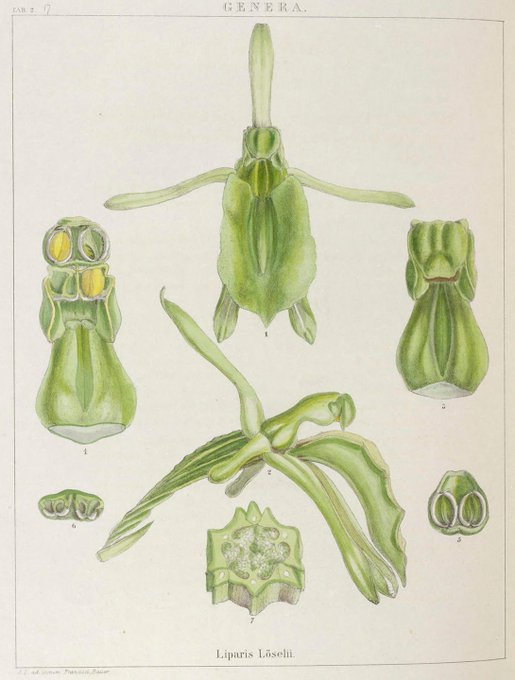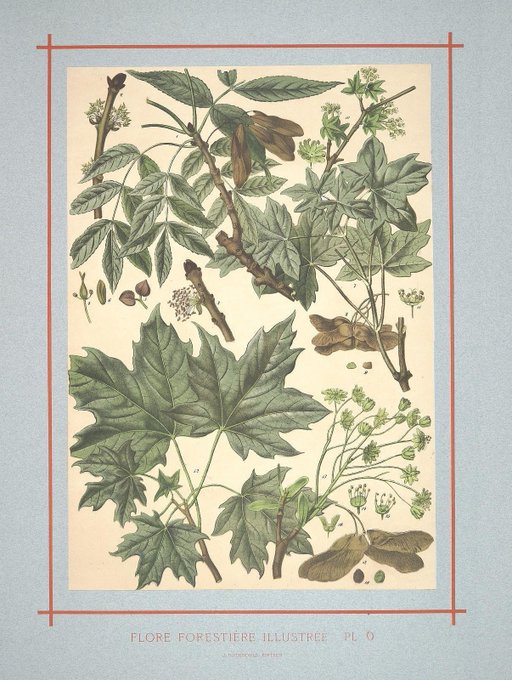BHLibのTwitterイラスト検索結果。 357 件中 5ページ目
"Trees and shrubs of the British Isles" (1909) was produced as a guide to help readers identify some 550 such native and commonly cultivated species of Britain. The 16 color plates are by C.F. Newall. In #BHLib via @GersteinLibrary @uoftlibraries ➡️ https://t.co/d7Vm66Z0b2
"Stirpes novae" (1784–1785) described, illustrated, and classified according to the Linnaean system plants new or largely unknown to science. Pierre-Joseph Redouté provided more than 50 plates for the work. Find it in #BHLib via @mobotgarden ➡️ https://t.co/440YapuD2U
The long-leaf sugarbush (Protea longifolia) is native to South Africa. #SciArt drawn and lithographed by C.F. Schmidt for "Icones plantarum rariorum Horti Regii Botanici Berolinensis" (1840-44), freely available in #BHLib via @Kew_LAA ➡️ https://t.co/YyqtMJwjyA #BotanicMonday
"Des champignons comestibles, suspects et vénéneux" (1827-28) is a rare mycological work with #SciArt depicting 200 mushroom species arranged according to edible, suspect, and poisonous species. Explore it in #BHLib via @LloydLibraryMus ➡️ https://t.co/AbQcxQziwt #FungiFriday
Mexican naturalist Rafael Montes de Oca's "Ensayo ornitologico de los troquilideos ó colibries de Mexico" (1875) describes 48 Mexican hummingbird species. Find it in #BHLib thanks to @SILibraries ➡️ https://t.co/a4pusCOlPI #HispanicHeritageMonth #Feathursday
🕷 Carl Ludwig Koch and Carl Wilhelm Hahn's "Die Arachniden" (1831–1848) helped establish wider German scientific interest in arachnology. Explore the multi-volume work in #BHLib thanks to @mayrlibrary & @BPLBoston ➡️ https://t.co/9Kh11IJA00 #spiders
"Recueil des plantes dessinées et gravées par ordre du roi Louis XIV", with over 300 beautiful engraved plates, was never formally published or offered for public sale. Explore the royal gift issue, produced in 1786, in #BHLib via @NYBG ➡️ https://t.co/EcWqewmy4t #FloraFriday
A variety of shells from Georges Cuvier's "The Animal Kingdom", v. 3 (1834) — an English translation of Cuvier's famous "Le Règne Animal" (first published in French in four octavo volumes in 1817). Contributed in #BHLib thanks to @NHM_Library ➡️ https://t.co/nlC9RzoEwu 🐚
"The Botanical Cabinet" (1817-1833) was a richly illustrated guide — featuring ~2,000 colored plates — to the plants that could be viewed & purchased from the Conrad Loddiges & Sons Nursery in London. View the work in #BHLib via @mobotgarden ➡️ https://t.co/LZ2lCZImnH
Meehan's "The Native Flowers and Ferns of the United States" (1878-79) presented a selection of indigenous US plants, with chromolithographs by L. Prang & Company after #SciArt from life by Alois Lunzer. In #BHLib via @MBLWHOILibrary ➡️ https://t.co/4rHIueQXY0 #BotanicMonday
Thistle is often used for members of the tribe Cardueae — especially members of the genera Carduus, Cirsium, and Onopordum. Explore some of these species in J. Sturms "Flora von Deutschland", Bd. 14 (1906), in #BHLib via @Kew_LAA ➡️ https://t.co/VIfjJsC7ll #FloraFriday
A variety of fish for #FishyFriday! #SciArt based on a watercolor drawing by William Saville Kent for his "Great Barrier Reef of Australia" (1893) — the first publication to extensively depict a coral reef in photographs. In #BHLib by @SILibraries ➡️ https://t.co/apOG0qIamY 🐠
"A history of the fishes of the British Islands" (1862-65) by Jonathan Couch was the 1st widely-available book on British fish featuring color plates, which were based on recently-caught specimens. In #BHLib via @Fisher_Library & @SILibraries: https://t.co/nF7DUrB7f0 #FishyFriday
Franz Bauer (1758-1840) was the 1st artist-in-residence at @kewgardens. Improved heating methods in the Gardens' glasshouses enabled the growth of #orchids, which Bauer illustrated & John Lindley published. Find the #SciArt in #BHLib via @NHM_Library ➡️ https://t.co/CmbUaRNzFA
The oxeye daisy (Leucanthemum vulgare) by Deborah Griscom Passmore from her album of American wildflowers. Passmore (1840-1911) was an artist for the @USDA Division of Pomology for 19 years. View her album in #BHLib via @USDA_ARS ➡️ https://t.co/ZqGZYwNwA5 #HerNaturalHistory
"Flore forestière" (1872) by Charles de Kirwan (then a sub-inspector of forests in France) describes the trees and shrubs of Europe. It is illustrated with 18 chromolithographs depicting 350 figures. Explore it in #BHLib via @mobotgarden ➡️ https://t.co/w8ElEJkJwj
The 25-volume "Icones florae Germanicae et Helveticae" (1834-1912) is a comprehensive work on the flora of middle Europe. It features over 3,000 hand-coloured engraved and lithographic plates. Explore the work in #BHLib thanks to @NYBG ➡️ https://t.co/ob3JMuLaew 🌸🌼🌸
Dinoflagellates for #TinyTuesday! The Free-living Unarmored Dinoflagellata (1921) by C. Kofoid & O. Swezy features #SciArt made by the authors from living material with the aid of a camera lueida & colored by Anna Hamilton. In #BHLib via @GersteinLibrary: https://t.co/hl6kbbf3if
Herpetologist and former director of @MCZHarvard Thomas Barbour was born #OTD 1884. He traveled the globe extensively for scientific studies, particularly throughout Cuba. Explore his "The Herpetology of Cuba" (1919) in #BHLib via @mayrlibrary ➡️ https://t.co/OfRTZ2bl23
Happy #Feathursday! The red-throated parrotfinch (Erythrura psittacea) is found in New Caledonia. #SciArt by H. Goodchild for "The Avicultural Magazine", v. 8 (1901-1902). Contributed in #BHLib via @AMNH ➡️ https://t.co/Mq3WsWox6V 🐦























































